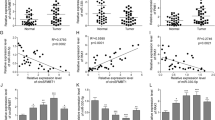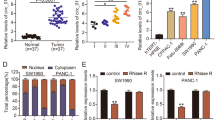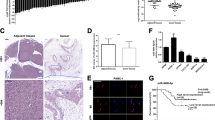Abstract
Recent researches demonstrate that microRNAs (miRNAs) are deregulated in numerous cancers and involved in tumorigenesis, whereas their influences on pancreatic cancer (PC) still need further elucidation. The present research revealed that miR-494 was significantly decreased in PC cell lines and tissues. Functional study showed that overexpressed miR-494 could remarkably inhibit proliferation of PC cells both in vitro and in vivo, which was due to induction of apoptosis, G1-phase arrest and senescence. Moreover, upregulated miR-494 significantly prohibited invasion of PC cells. Meanwhile, both c-Myc and SIRT1 was identified as targets of miR-494 through dual luciferase assay and further confirmed by the reverse correlation between miR-494 and c-Myc/SIRT1 in PC samples. Furthermore, co-transfection with c-Myc-RNAi and SIRT1-RNAi synergistically reduced c-Myc and SIRT1 expression, and inhibited proliferation of PC, which simulated the effects of miR-494 overexpression. On the contrary, co-overexpression of c-Myc and SIRT1 effectively rescued inhibition of overexpressed miR-494 on PC cells. The clinical characteristics further revealed that low miR-494 correlated with larger tumor size, late tumor node metastasis stage, lymphatic invasion, distant metastasis and poor prognosis. In conclusion, the present study indicated that miR-494 might serve as predictor and inhibitor in PC by directy downregulating the loop of c-Myc and SIRT1.
This is a preview of subscription content, access via your institution
Access options
Subscribe to this journal
Receive 12 print issues and online access
$259.00 per year
only $21.58 per issue
Buy this article
- Purchase on Springer Link
- Instant access to full article PDF
Prices may be subject to local taxes which are calculated during checkout





Similar content being viewed by others
References
Gregory RI, Chendrimada TP, Cooch N, Shiekhattar R . Human RISC couples microRNA biogenesis and posttranscriptional gene silencing. Cell 2005; 123: 631–640.
Moriyama T, Ohuchida K, Mizumoto K, Yu J, Sato N, Nabae T et al. MicroRNA-21 modulates biological functions of pancreatic cancer cells including their proliferation, invasion, and chemoresistance. Mol Cancer Ther 2009; 8: 1067–1074.
Calin GA, Croce CM . MicroRNA signatures in human cancers. Nat Rev Cancer 2006; 6: 857–866.
Volinia S . A microRNA expression signature of human solid tumors defines cancer gene targets. Proc Natl Acad Sci USA 2006; 103: 2257–2261.
Lim LP, Lau NC, Garrett-Engele P, Grimson A, Schelter JM, Castle J et al. Microarray analysis shows that some microRNAs downregulate large numbers of target mRNAs. Nature 2005; 433: 769–773.
Wurdinger T, Costa FF . Molecular therapy in the microRNA era. Pharmacogenom J 2006; 7: 297–304.
Szafranska AE, Davison TS, John J, Cannon T, Sipos B, Maghnouj A et al. MicroRNA expression alterations are linked to tumorigenesis and non-neoplastic processes in pancreatic ductal adenocarcinoma. Oncogene 2007; 26: 4442–4452.
Bloomston M, Frankel WL, Petrocca F, Volinia S, Alder H, Hagan JP et al. MicroRNA expression patterns to differentiate pancreatic adenocarcinoma from normal pancreas and chronic pancreatitis. JAMA 2007; 297: 1901–1908.
Zhang Y, Li M, Wang H, Fisher WE, Lin PH, Yao Q et al. Profiling of 95 micrornas in pancreatic cancer cell lines and surgical specimens by real-time PCR analysis. World J Surg 2008; 33: 698–709.
Rachagani S, Kumar S, Batra SK . MicroRNA in pancreatic cancer: pathological, diagnostic and therapeutic implications. Cancer Lett 2010; 292: 8–16.
Eilers M, Eisenman RN . Myc's broad reach. Genes Dev 2008; 22: 2755–2766.
Natalie Meyer, Penn LZ . Reflecting on 25 years with MYC. Nat Rev Cancer 2008; 8: 976–990.
Albihn A, Johnsen JI, Arsenian Henriksson M . MYC in oncogenesis and as a target for cancer therapies. Adv Cancer Res 2010; 107: 163–224.
Wu CH, Van Riggelen J, Yetil A, Fan AC, Bachireddy P, Felsher DW . Cellular senescence is an important mechanism of tumor regression upon c-Myc inactivation. Proc Natl Acad Sci USA 2007; 104: 13028.
Felsher DW . Oncogene addiction versus oncogene amnesia: perhaps more than just a bad habit? Cancer Res 2008; 68: 3081.
Jain M, Arvanitis C, Chu K, Dewey W, Leonhardt E, Trinh M et al. Sustained loss of a neoplastic phenotype by brief inactivation of MYC. Sci STKE 2002; 297: 102.
He C, Jiang H, Geng S, Sheng H, Shen X, Zhang X et al. Expression and prognostic value of c-Myc and Fas (CD95/APO1) in patients with pancreatic cancer. Int J Clin Exp Pathol 2014; 7: 742–750.
Mao B, Zhao G, Lv X, Chen HZ, Xue Z, Yang B et al Int J Biochem Cell Biol 2011; 43: 1573–1581.
Marshall GM, Liu PY, Gherardi S, Scarlett CJ, Bedalov A, Xu N et al PLoS Genet 2011; 7: e1002135.
Menssen A, Hermeking H . c-MYC and SIRT1 locked in a vicious cycle. Oncotarget 2012; 3: 112–113.
Menssen A, Hydbring P, Kapelle K, Vervoorts J, Diebold J, Lüscher B et al. The c-MYC oncoprotein, the NAMPT enzyme, the SIRT1-inhibitor DBC1, and the SIRT1 deacetylase form a positive feedback loop. Proc Natl Acad Sci USA 2012; 109: E187–E196.
Yuan J, Minter-Dykhouse K, Lou Z . A c-Myc-SIRT1 feedback loop regulates cell growth and transformation. J Cell Biol 2009; 185: 203–211.
Zhao G, Cui J, Zhang J, Qin Q, Chen Q, Yin T et al. SIRT1 RNAi knockdown induces apoptosis and senescence, inhibits invasion and enhances chemosensitivity in pancreatic cancer cells. Gene Therapy 2011; 18: 920–928.
Selaru FM, Olaru AV, Kan T, David S, Cheng Y, Mori Y et al. MicroRNA‐21 is overexpressed in human cholangiocarcinoma and regulates programmed cell death 4 and tissue inhibitor of metalloproteinase 3. Hepatology 2009; 49: 1595–1601.
Mardin WA, Mees ST . MicroRNAs: novel diagnostic and therapeutic tools for pancreatic ductal adenocarcinoma? Ann Surg Oncol 2009; 16: 3183–3189.
Zhao G, Qin Q, Zhang J, Liu Y, Deng S, Liu L et al. Hypermethylation of HIC1 promoter and aberrant expression of HIC1/SIRT1 might contribute to the carcinogenesis of pancreatic cancer. Ann Surg Oncol 2012; 3: S301–S311.
Chang SS, Jiang WW, Smith I, Poeta LM, Begum S, Glazer C et al. MicroRNA alterations in head and neck squamous cell carcinoma. Int J Cancer 2008; 123: 2791–2797.
Zhao JJ, Yang J, Lin J, Yao N, Zhu Y, Zheng J et al. Identification of miRNAs associated with tumorigenesis of retinoblastoma by miRNA microarray analysis. Child's Nerv Syst 2009; 25: 13–20.
Roccaro AM, Sacco A, Chen C, Runnels J, Leleu X, Azab F et al. microRNA expression in the biology, prognosis, and therapy of Waldenström macroglobulinemia. Blood 2009; 113: 4391–4402.
Liu L, Jiang Y, Zhang H, Greenlee AR, Han Z . Overexpressed miR-494 down-regulates PTEN gene expression in cells transformed by anti-benzo(apyrene-trans-7,8-dihydrodiol-9,10-epoxide. Life Sci 2010; 86: 192–198.
Jung P, Menssen A, Mayr D, Hermeking H . AP4 encodes a c-MYC-inducible repressor of p21. Proc Natl Acad Sci USA 2008; 105: 15046–15051.
Magid R, Murphy TJ, Galis ZS . Expression of matrix metalloproteinase-9 in endothelial cells is differentially regulated by shear stress. Role of c-Myc. J Biol Chem 2003; 278: 32994–32999.
Lu Q, Hong W . Bcl2 enhances c-Myc-mediated MMP-2 expression of vascular smooth muscle cells. Cell Signal 2009; 21: 1054–1059.
Lovaas JD, Zhu L, Chiao CY, Byles V, Faller DV, Dai Y . SIRT1 enhances matrix metalloproteinase-2 expression and tumor cell invasion in prostate cancer cells. Prostate 2013; 73: 522–530.
Menssen A, Hydbring P, Kapelle K, Vervoorts J, Diebold J, Lüscher B et al. The c-MYC oncoprotein, the NAMPT enzyme, the SIRT1-inhibitor DBC1, and the SIRT1 deacetylase form a positive feedback loop. Proc Natl Acad Sci USA 2012; 109: 187–196.
Acknowledgements
This study was supported from the National Science Foundation Committee (NSFC) of China (Grant number: 30972900 and 81372666) and the Research Special Fund for Public Welfare Industry of Health of China (Grant number: 201202007).
Author information
Authors and Affiliations
Corresponding authors
Ethics declarations
Competing interests
The authors declare no conflict of interest.
Additional information
Supplementary Information accompanies this paper on Gene Therapy website
Rights and permissions
About this article
Cite this article
Liu, Y., Li, X., Zhu, S. et al. Ectopic expression of miR-494 inhibited the proliferation, invasion and chemoresistance of pancreatic cancer by regulating SIRT1 and c-Myc. Gene Ther 22, 729–738 (2015). https://doi.org/10.1038/gt.2015.39
Received:
Revised:
Accepted:
Published:
Issue Date:
DOI: https://doi.org/10.1038/gt.2015.39
This article is cited by
-
A Tale of Two: When Neural Stem Cells Encounter Hypoxia
Cellular and Molecular Neurobiology (2023)
-
Circular RNA circ_0081001 knockdown enhances methotrexate sensitivity in osteosarcoma cells by regulating miR-494-3p/TGM2 axis
Journal of Orthopaedic Surgery and Research (2021)
-
MicroRNA-494-3p inhibits formation of fast oxidative muscle fibres by targeting E1A-binding protein p300 in human-induced pluripotent stem cells
Scientific Reports (2021)
-
miR-494 induces EndMT and promotes the development of HCC (Hepatocellular Carcinoma) by targeting SIRT3/TGF-β/SMAD signaling pathway
Scientific Reports (2019)
-
MiRNA-646-mediated reciprocal repression between HIF-1α and MIIP contributes to tumorigenesis of pancreatic cancer
Oncogene (2018)



